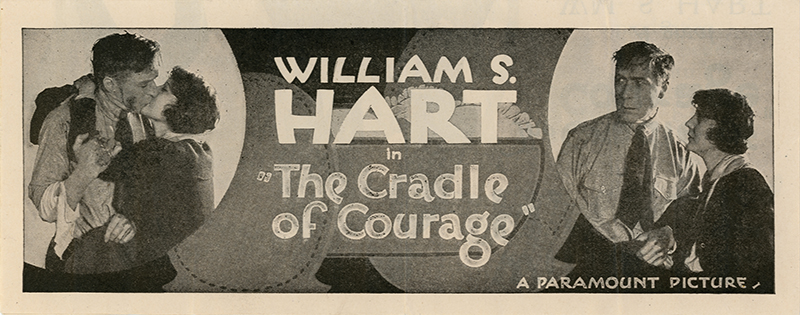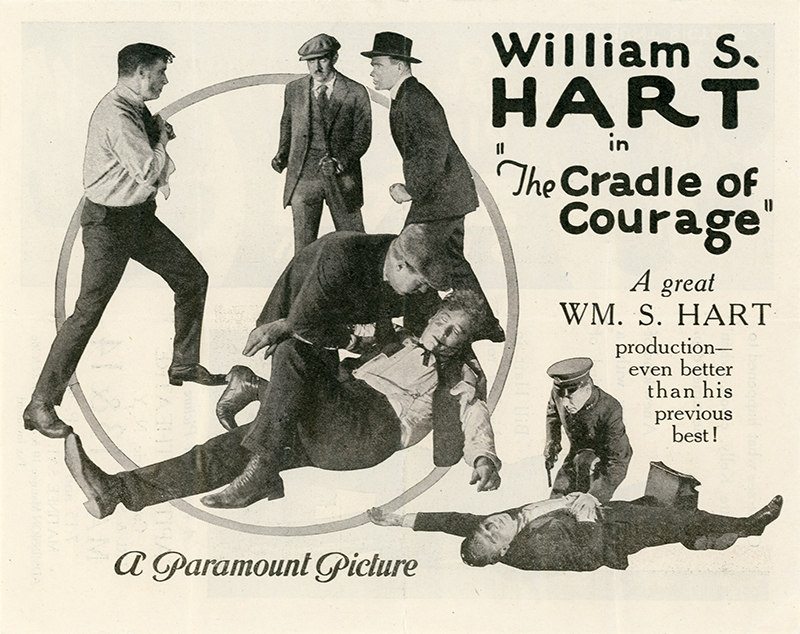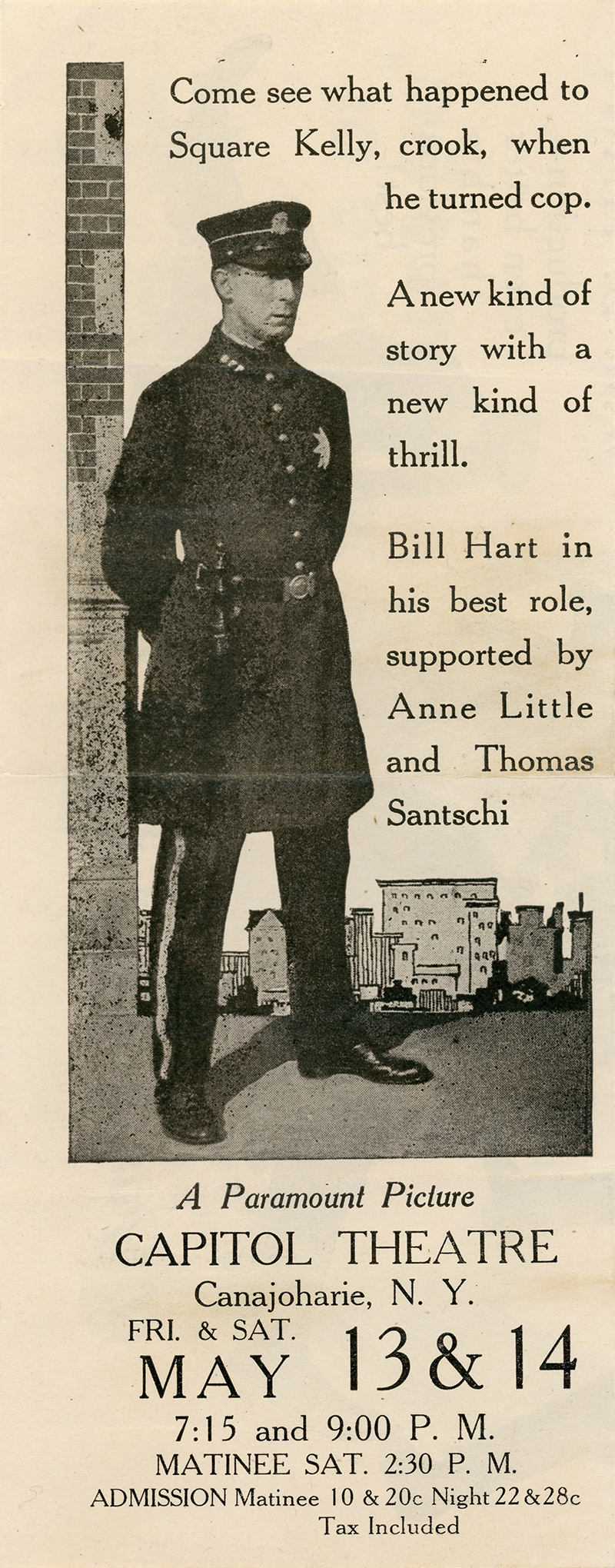|
|


Movie herald (advertising brochure) for the 1920 Paramount-Artcraft feature, "The Cradle of Courage," starring William S. Hart. It's heralding a run at a theater in Montgomery County, New York, May 13-14. No year indicated, but probably 1921; the film premiered on Broadway in September 1920. One double-sided page, 7x9 inches, folded horizontally.
From Koszarski 1980, pg. 124:
Produced by William S. Hart Company; distributed by Paramount-Artcraft; New York premiere September 19, 1920; released October 17, 1920; ©July 26, 1920; five reels (4737 feet). Directed by Lambert Hillyer; screenplay by Lambert Hillyer from a story by Frederick Bradbury; photographed by Joe August; art director, J.C. Hoffner; art titles by Harry Barndollar. CAST: William S. Hart ("Square" Kelly); Ann Little (Rose Tierney); Thomas Santschi (Tierney); Gertrude Claire (Mother Kelly); Francis Thorwald (Jim Kelly); George Williams (Lieutenant Riley). SYNOPSIS: From the "Cradle of Courage" (the American Expeditionary Force in Europe) comes back to San Francisco "Square" Kelly with a fine record though a former leader of a gang of crooks. His chum is the son of a police captain, and the latter feels so kindly disposed toward "Square" that he offers the ex-burglar a place on the force. None of "Square's" friends is at the wharf to meet him, and he feels inclined to make a complete change in his life. On encountering them at their hangout, however, they convince him there is only one existence possible, and enlist his services in a prospective raid. His own mother encourages this, but not Rose, adopted daughter of gang leader Tierney. It is this girl, who has preserved a clean mind in unclean surroundings, who decides the future of "Square." Once in police service, after a bitter struggle with Tierney, "Square" lays for his former confederates at a house they intend to rob. He finds Rose lurking there and unjustly accuses her of hypocrisy, whereas she has haunted the place to save him from being "croaked." He finally traps the gang at work and, in a running fight, his own brother is killed. "Square" does not have this to soil his career, for the shot was fired by one of the gang when the erring brother refused to shoot "Square." In plain clothes "Square" visits his mother and reveals that the crooks were responsible for the killing and converts her to his better ideals. He also dares invade the den of the gang. He is badly wounded there but he breaks up the gang and is rescued by Rose. By her and his transformed mother he is nursed back to health. In the true love of loyal Rose he finds reason to be profoundly glad that he has been taught to master himself. (Moving Picture World, October 2, 1920.) REVIEWS: ... The change in surroundings has ... provided the star with the opportunity to render a characterization of unusual strength but regrettably the story is weak in general material while a brace of important dramatic situations fall short of ringing true. [The] direction [is] generally satisfactory but action is strung out too much. (Wid's, September 26, 1920.) Hart is too distinctly an American type to play the part of an Irishman, but he makes a manly attempt to bring out of the story an interest in expressing his better self, and he succeeds in doing so through sheer force of personality. This is all the more difficult because there is nothing in his sober and intense physiognomy to suggest the rollicking and devil-may-care Irishman of tradition ... while the love interest is slight, Ann Little gives it full value with dignity and rare sympathetic insight. Her performance adds greatly to the charm of a story that is mostly about the misdeeds of men. ... (Louis Reeves Harrison, Moving Picture World, October 2, 1920.)
LW3167: 9600 dpi jpeg from original herald purchased 2017 by Leon Worden.
|
WATCH FULL MOVIES
Biography
(Mitchell 1955)
Narrated Biopic 1960
Biography (Conlon/ McCallum 1960)
Biography (Child, NHMLA 1987)
Essay: The Good Bad Man (Griffith & Mayer 1957)
Film Bio, Russia 1926
The Disciple 1915/1923
The Captive God 1916 x2
The Aryan 1916 x2
The Primal Lure 1916
The Apostle of Vengeance (Mult.)
Return of Draw Egan 1916 x2
Truthful Tulliver 1917
The Gun Fighter 1917 (mult.)
Wolf Lowry 1917
The Narrow Trail 1917 (mult.)
Wolves of the Rail 1918
Riddle Gawne 1918 (mult.)
"A Bullet for Berlin" 1918 (4th Series)
The Border Wireless 1918 (Mult.)
Branding Broadway 1918 x2
Breed of Men 2-2-1919 Rivoli Premiere
The Poppy Girl's Husband 3-23-1919 Rivoli Premiere
The Money Corral 4-20-1919 Rialto Premiere
Square Deal Sanderson 1919
Wagon Tracks 1919 x3
Sand 1920 Lantern Slide Image
The Toll Gate 1920 (Mult.)
The Cradle of Courage 1920
The Testing Block 1920:
Slides, Lobby Cards, Photos (Mult.)
O'Malley/Mounted 1921 (Mult.)
The Whistle 1921 (Mult.)
White Oak 1921 (Mult.)
Travelin' On 1921/22 (Mult.)
Three Word Brand 1921
Wild Bill Hickok 1923 x2
Singer Jim McKee 1924 (Mult.)
"Tumbleweeds" 1925/1939
Hart Speaks: Fox Newsreel Outtakes 1930
|
The site owner makes no assertions as to ownership of any original copyrights to digitized images. However, these images are intended for Personal or Research use only. Any other kind of use, including but not limited to commercial or scholarly publication in any medium or format, public exhibition, or use online or in a web site, may be subject to additional restrictions including but not limited to the copyrights held by parties other than the site owner. USERS ARE SOLELY RESPONSIBLE for determining the existence of such rights and for obtaining any permissions and/or paying associated fees necessary for the proposed use.







































